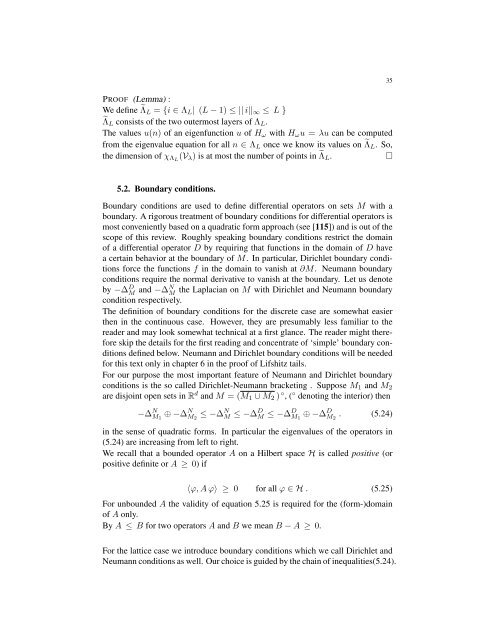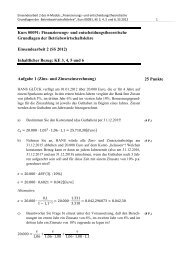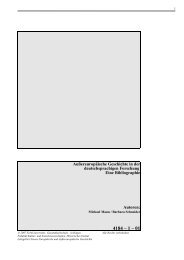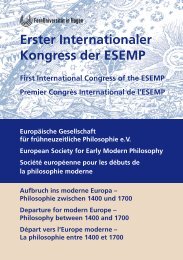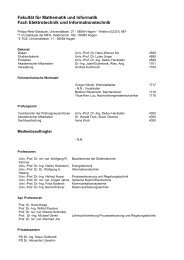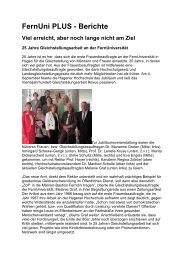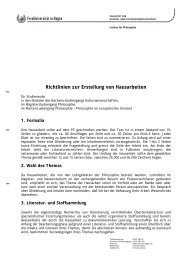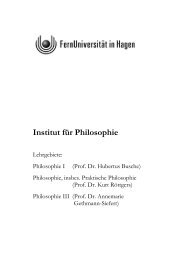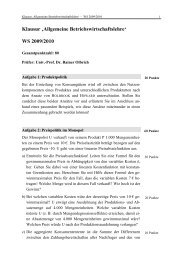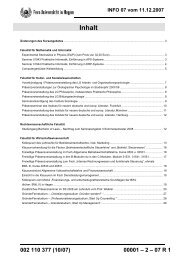An Invitation to Random Schr¨odinger operators - FernUniversität in ...
An Invitation to Random Schr¨odinger operators - FernUniversität in ...
An Invitation to Random Schr¨odinger operators - FernUniversität in ...
You also want an ePaper? Increase the reach of your titles
YUMPU automatically turns print PDFs into web optimized ePapers that Google loves.
PROOF (Lemma) :<br />
We def<strong>in</strong>e ˜Λ L = {i ∈ Λ L | (L − 1) ≤ || i|| ∞ ≤ L }<br />
˜Λ L consists of the two outermost layers of Λ L .<br />
The values u(n) of an eigenfunction u of H ω with H ω u = λu can be computed<br />
from the eigenvalue equation for all n ∈ Λ L once we know its values on ˜Λ L . So,<br />
the dimension of χ ΛL (V λ ) is at most the number of po<strong>in</strong>ts <strong>in</strong> ˜Λ L .<br />
□<br />
35<br />
5.2. Boundary conditions.<br />
Boundary conditions are used <strong>to</strong> def<strong>in</strong>e differential opera<strong>to</strong>rs on sets M with a<br />
boundary. A rigorous treatment of boundary conditions for differential opera<strong>to</strong>rs is<br />
most conveniently based on a quadratic form approach (see [115]) and is out of the<br />
scope of this review. Roughly speak<strong>in</strong>g boundary conditions restrict the doma<strong>in</strong><br />
of a differential opera<strong>to</strong>r D by requir<strong>in</strong>g that functions <strong>in</strong> the doma<strong>in</strong> of D have<br />
a certa<strong>in</strong> behavior at the boundary of M. In particular, Dirichlet boundary conditions<br />
force the functions f <strong>in</strong> the doma<strong>in</strong> <strong>to</strong> vanish at ∂M. Neumann boundary<br />
conditions require the normal derivative <strong>to</strong> vanish at the boundary. Let us denote<br />
by −∆ D M and −∆N M<br />
the Laplacian on M with Dirichlet and Neumann boundary<br />
condition respectively.<br />
The def<strong>in</strong>ition of boundary conditions for the discrete case are somewhat easier<br />
then <strong>in</strong> the cont<strong>in</strong>uous case. However, they are presumably less familiar <strong>to</strong> the<br />
reader and may look somewhat technical at a first glance. The reader might therefore<br />
skip the details for the first read<strong>in</strong>g and concentrate of ‘simple’ boundary conditions<br />
def<strong>in</strong>ed below. Neumann and Dirichlet boundary conditions will be needed<br />
for this text only <strong>in</strong> chapter 6 <strong>in</strong> the proof of Lifshitz tails.<br />
For our purpose the most important feature of Neumann and Dirichlet boundary<br />
conditions is the so called Dirichlet-Neumann bracket<strong>in</strong>g . Suppose M 1 and M 2<br />
are disjo<strong>in</strong>t open sets <strong>in</strong> R d and M = (M 1 ∪ M 2 ) ◦ , ( ◦ denot<strong>in</strong>g the <strong>in</strong>terior) then<br />
−∆ N M 1<br />
⊕ −∆ N M 2<br />
≤ −∆ N M ≤ −∆ D M ≤ −∆ D M 1<br />
⊕ −∆ D M 2<br />
. (5.24)<br />
<strong>in</strong> the sense of quadratic forms. In particular the eigenvalues of the opera<strong>to</strong>rs <strong>in</strong><br />
(5.24) are <strong>in</strong>creas<strong>in</strong>g from left <strong>to</strong> right.<br />
We recall that a bounded opera<strong>to</strong>r A on a Hilbert space H is called positive (or<br />
positive def<strong>in</strong>ite or A ≥ 0) if<br />
〈ϕ, A ϕ〉 ≥ 0 for all ϕ ∈ H . (5.25)<br />
For unbounded A the validity of equation 5.25 is required for the (form-)doma<strong>in</strong><br />
of A only.<br />
By A ≤ B for two opera<strong>to</strong>rs A and B we mean B − A ≥ 0.<br />
For the lattice case we <strong>in</strong>troduce boundary conditions which we call Dirichlet and<br />
Neumann conditions as well. Our choice is guided by the cha<strong>in</strong> of <strong>in</strong>equalities(5.24).


